
The final proof: Novemeber 2010
October 25, 2010
By Stephanie Ortenzi
Delivery trumps content” is one of my favourite unoriginal sayings. It
means no matter what’s inside, how it gets to its destination is more
important. This is great for packagers. To be fair, the product won’t go
anywhere without them, but packaging is a curious phenomenon.
Packaging goes from indispensable to a controversial wasteland of reuse or disintegration.
Delivery trumps content” is one of my favourite unoriginal sayings. It means no matter what’s inside, how it gets to its destination is more important. This is great for packagers. To be fair, the product won’t go anywhere without them, but packaging is a curious phenomenon. At the outset of a product’s life, packaging is indispensable. As soon as the sale is made and the product fulfils its destiny, like a baguette that’s going to be spread with butter and jam at breakfast, the packaging is dead. It has given its life for a good cause. And then packaging gets the brunt of the blame for our ecological state.
 |
|
| The industry’s efforts to make sustainable and environmentally friendly packaging are just part of the equation. Advertisement
|
Considering packaging as a metaphor. What image works for you? Clothing? That grey sweater I just bought is going to be a wardrobe staple all winter. Shelter? My dollar-store umbrella is still kicking two years later (I hope I didn’t just jinx it). What about packaging as a conduit? That plastic bag around the loaf of bread I just opened – is it like a pipeline that carries the bread to me?
In playing with these metaphors, the irony of the pipeline is deliberate. An enormous amount of the plastic used in packaging is dependent on fossil fuel, but I don’t want to contribute to that sinking feeling of helplessness we get when we think about the gargantuan task of “greening” our packaging.
For one thing, it’s happening already.
Companies like Compostech are a great source of good news when it comes to green packaging. They have three lines of paper packaging that are bamboo and sugarcane based. Cornstarch is the driving ingredient in another line of packaging that includes cutlery. And they also have polylactic acid (PLA) products to replace clear plastics, lidded bowls, portion cups and the like. PLA is made from corn, wheat and beets that have had their starch extracted, which produces dextrose and then gets put through a fermentation stage that produces lactic acid. The result is a transparent biodegradable plastic.
All of which could be cause for jubilation, but not until we’ve sorted out biodegradable versus compostable. If a product is biodegradable, it’s usually made from plant or animal sources. Over time, it will break down from naturally occurring micro-organisms, like fungi or bacteria. The dark side: biodegradable products can create methane and may contain toxins. If a product is going to be designated compostable, it must be able to decompose into carbon dioxide, water and biomass at the same rate as paper. It can’t produce any toxic material and should be able to support plant life.
James Downham, president and CEO of The Packaging Association, points to the heart of what he feels is important in packaging today. “It’s absolutely the responsibility of the packaging industry to do its best to produce sustainable and environmentally responsible packaging, but this is only the first third of the equation.”
The next stage is what happens when it gets into and then leaves the hands of the consumer.
It’s not always obvious, he points out, where specific kinds of packaging can go, and our municipalities – which decide how they’re going to manage our local waste – don’t always make it clear.
Downham talks about one of the beautiful aspects of the recycling processes currently in play for those two-litre pop bottles that we produce, fill, empty and discard in great quantity. Essentially, they’re ground down, turned into pellets and then turned into new bottles. However, there are some plastics, Downham says, that an eastern Ontario municipality won’t take in its blue box. Once this new plastic enters the waste stream (as it’s known), it can contaminate the batch and make all that diligent recycling for naught.
“There’s a tendency to simplify the discussion” says Downham, “which is really very complex, and I don’t think people get that.…We have a lack of harmonization from province to province in terms of how packaging is handled as waste, and all the factors need to come together.”
Downham says we need to invest in education so we can make the most of our developments in greener packaging. The irony of wasting the chance to put some packaging fruitfully into a renewable ecosystem is enough to make you want to cry. It makes me think of this scene from some French movie. A woman is leaving a bakery with a baguette that’s “wrapped” with a white paper band in the centre so that she can hold it and keep her hands crumb-free. I mostly love this image because “packaging” is as much an idea as it is a thing.
Stephanie Ortenzi (www.pistachiowriting.com ) is a Toronto-based food marketing writer.
Print this page
Leave a Reply